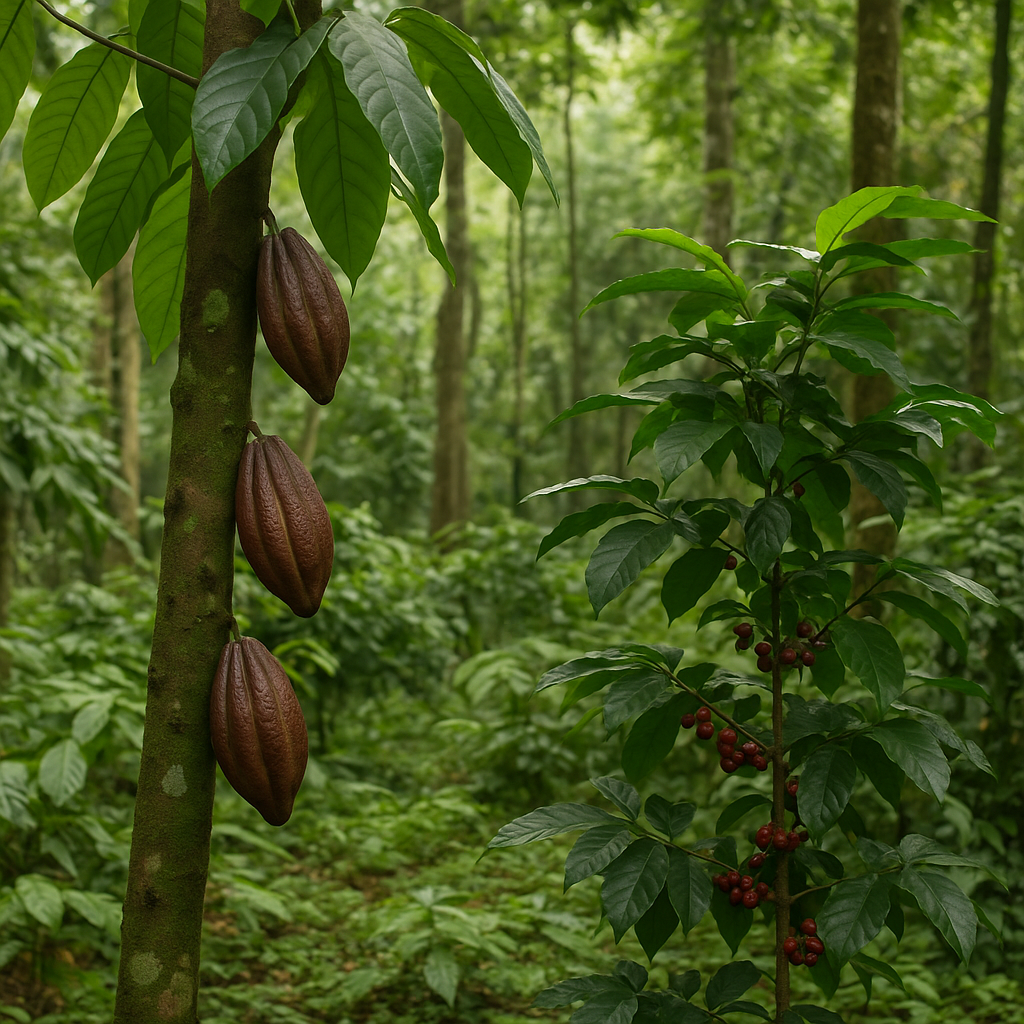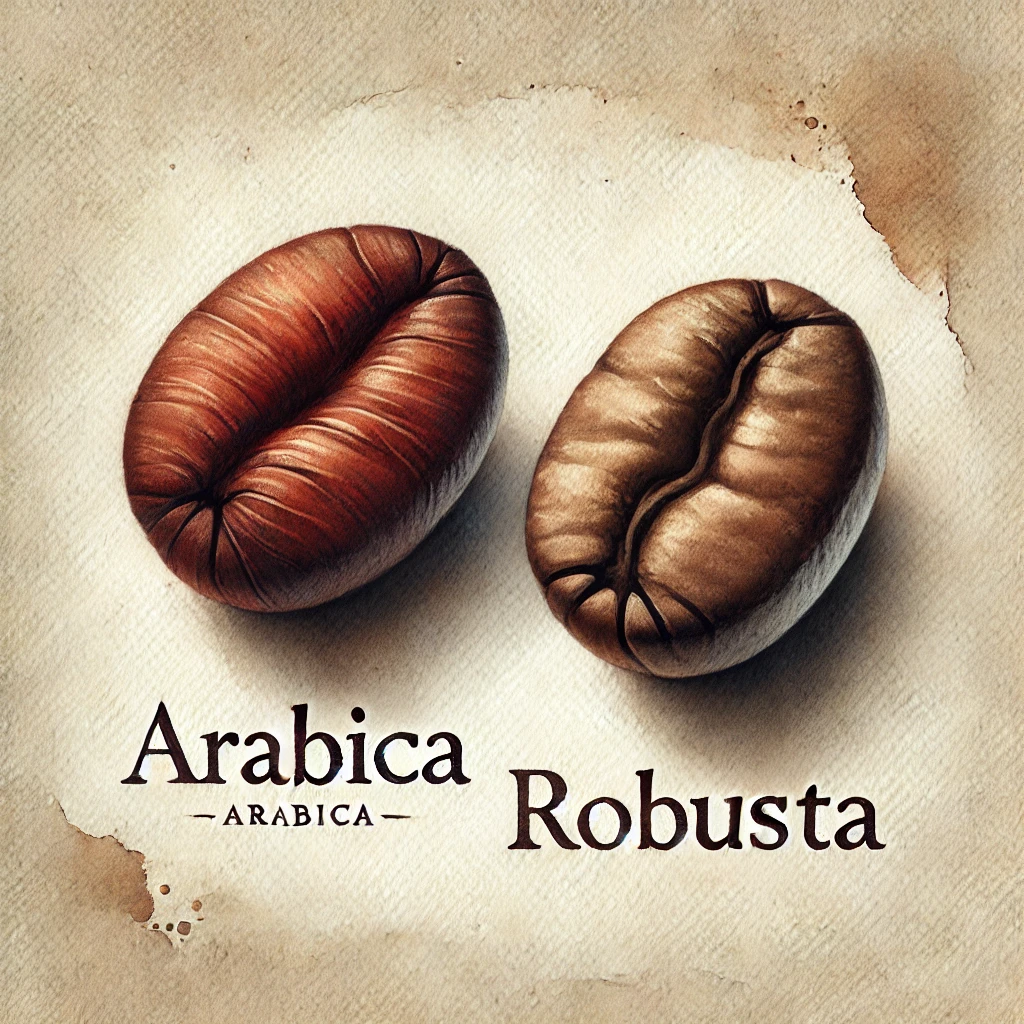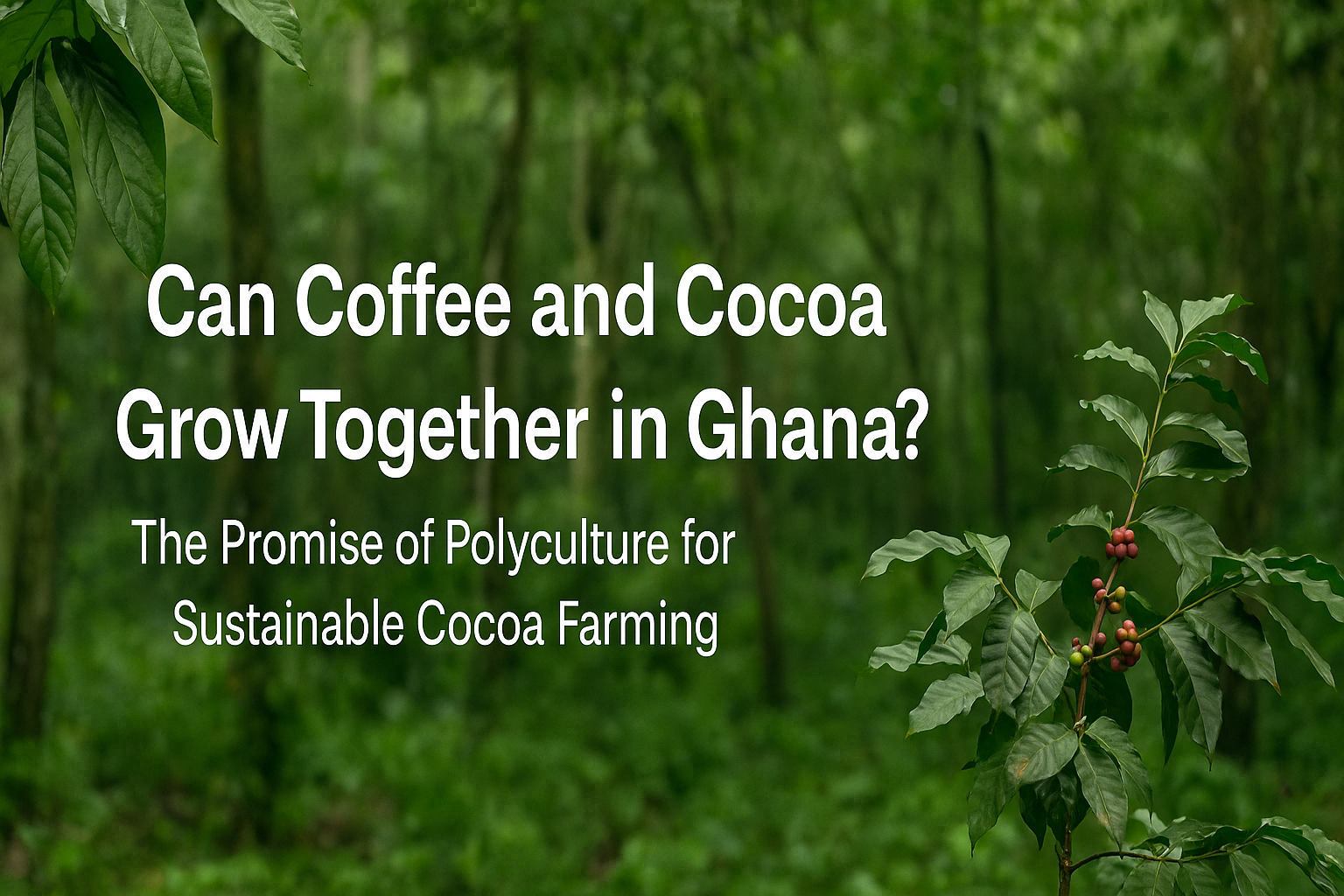 The Promise of Polyculture for Cocoa Farmers
The Promise of Polyculture for Cocoa Farmers
Whenever I visit São Tomé and Príncipe, I always call in to see my friend Claudio Corallo — a pioneer of tree-to-bar chocolate. One thing that struck me on my first visit was that he grows not just fine cocoa, but coffee too — on the same land. It got me thinking: why don’t we see more of this in West Africa? Could it work in Ghana’s cocoa farms?
As a chocolatier, cocoa educator, and someone who works closely with cocoa farmers and cooperatives, I’m always exploring ways to help cocoa farms thrive — both environmentally and economically. One idea that keeps popping up is intercropping cocoa with coffee — a form of polyculture farming.
But is this just another farming fad, or could it truly benefit Ghanaian cocoa farmers
The short answer is: yes — it can and does, but it has to be done with care. In fact, coffee and cocoa can complement each other surprisingly well.
Why Cocoa and Coffee Are Good Neighbours in Agroforestry
Cocoa and coffee are natural allies in the forest. Both evolved under the tropical rainforest canopy and share similar growing requirements:
Filtered sunlight — especially when young
Warm, humid climate — 21–30°C
Well-drained, fertile soils rich in organic matter
Annual rainfall — 1,200–2,000 mm
In Ghana’s cocoa belt — spanning Western, Ashanti, Brong-Ahafo, Eastern, and parts of the Volta Region — these conditions are ideal for both crops.
 Robusta coffee (Coffea canephora) is already grown here in small quantities, and more farmers are starting to revive coffee cultivation. Arabica coffee can also grow well in cooler, higher-elevation zones, such as the Akwapim Hills and Togo Hills.
Robusta coffee (Coffea canephora) is already grown here in small quantities, and more farmers are starting to revive coffee cultivation. Arabica coffee can also grow well in cooler, higher-elevation zones, such as the Akwapim Hills and Togo Hills.
The Benefits of Growing Coffee with Cocoa
Diversified Income: Relying on cocoa alone can be risky — weather, pests, diseases, or volatile cocoa market prices can hit hard. Intercropping with coffee offers a second income stream, often filling the gaps between cocoa payments.
Labour Spread Across the Year
Cocoa harvest: major season Oct–Jan, minor May–Aug Coffee harvest: often ripens Aug–Dec
This spreads out labour demands and provides steadier income for farming families.
Improved Farm Resilience & Biodiversity
Polyculture increases biodiversity, improving natural pest control and soil health.
Coffee bushes act as understorey plants, creating a better microclimate for cocoa.
Different root depths reduce competition and promote healthier soils.
Climate Change Adaptation
As some cocoa zones get warmer or drier, coffee may prove more resilient — particularly in higher elevations or as shade crops.
Potential for Premium Products & Agro-Tourism
Imagine: Ghana-grown chocolate paired with Ghana-grown coffee — both from the same farm. This “bean-to-bar and bean-to-cup” story offers fantastic opportunities for chocolate tourism and export markets.
What to Watch Out For
Of course, it’s no silver bullet. Farmers must manage carefully:
Shade Management
Too much shade = higher fungal risk for cocoa
Too little shade = coffee struggles
Use suitable shade trees such as gliricidia, plantain, albizia, or cola, which can also provide extra income.
Spacing & Competition
Coffee bushes need space — at least 2 x 2 m spacing
Avoid overcrowding, which stresses cocoa roots.
Many farmers plant coffee between cocoa rows, or start new plots on farm edges.
Pests & Diseases
Cocoa: black pod disease, capsid bugs
Coffee: coffee berry borer, leaf rust
Mixed farms help balance pest pressure but require active monitoring.
Market Access
Coffee markets in Ghana are smaller than cocoa.
However, specialty coffee demand is rising — both domestically and for export.
Selling quality coffee requires good processing — careful drying, sorting, and storage.
Real Examples from Ghana & West Africa
Ghana
COCOBOD and NGOs (e.g. SNV, Rainforest Alliance) are piloting cocoa–coffee intercropping in Brong-Ahafoand Ashanti.
Farmers around Nkawkaw and parts of the Eastern Region are reviving old coffee plots alongside cocoa.
Urban demand for Ghana-grown coffee is growing fast.
Cameroon
Many cocoa farmers in Cameroon’s Centre Region intercrop with robusta coffee.
NGO projects show improved income stability and farm resilience with both crops.
Uganda
Cocoa–coffee farms in Western Uganda (Bundibugyo) demonstrate improved soil fertility and climate resiliencethrough polyculture.
Tips for Farmers Considering Cocoa + Coffee
Start small — try 0.25 to 0.5 ha plots first.
Use known coffee varieties suited to your area — often robusta in Ghana.
Manage shade actively — not too dense, not too open.
Learn about coffee processing — drying is key!
Connect with local buyers — some specialty coffee exporters now operate in Ghana.
A Future-Friendly Farming Model
I see coffee + cocoa intercropping as an ideal model for Ghana’s future cocoa farms:
Better biodiversity
More stable income
Enhanced climate resilience
New market opportunities: bean-to-bar and bean-to-cup, agro-tourism, carbon credits
Carbon credit projects are already being piloted in West Africa, rewarding farmers for managing polyculture agroforestry systems that boost carbon sequestration.
Cocoa and coffee aren’t just tasty companions — they can be farming companions too. Agroforestry and polyculturehold the key to sustainable, farmer-friendly cocoa systems in Ghana.
And who knows — in a few years, we might see bean-to-bar and bean-to-cup tours across Ghana, offering visitors a taste of both of these beautiful crops.
If you’re a Ghanaian cocoa farmer interested in trying cocoa + coffee intercropping, there are resources and support available:
